Secrets of front photos
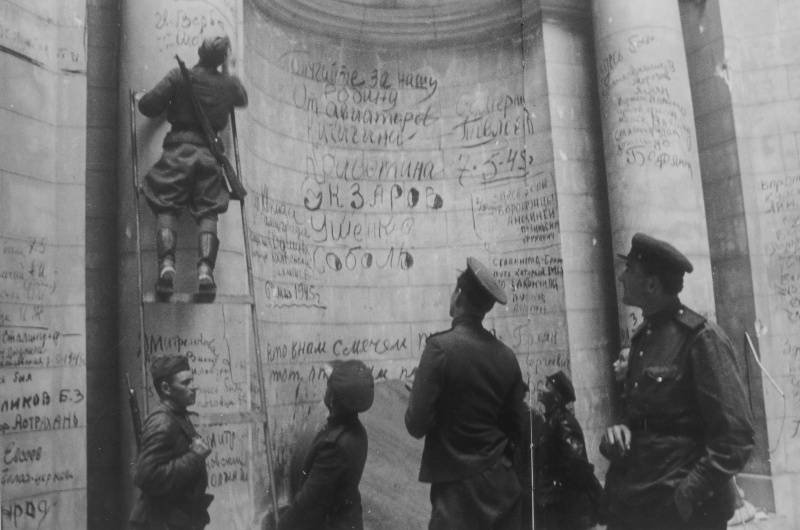
The front line passed from hand to hand. At some point, the Nazis went on the offensive. Anna was cut off from her, she had to hide among the dead. The noise of the onslaught of enemies inexorably approached, she pulled out a pistol and inserted the barrel into her mouth. Being discovered by enemies means captivity!
Family photos become witnesses historical events that come to life with renewed vigor when the investigation of the circumstances of their occurrence begins.
On the threshold of the Reichstag
Eseniya Fomenko, a student of the 6 class, said: “I wanted to share with you the story of a photograph stored in our family. A wonderful photograph “On the threshold of the Reichstag” was brought from the war by Fomenko Mark Dmitrievich, my great-grandfather. In the photo: a group of Soviet soldiers on the steps of the Reichstag. Among a large number of faces there is the face of my great-grandfather. He participated in the assault on this main den of the Nazis and left his autograph on the walls of the Reichstag with other fighters: “We reached Berlin”, “This is our Victory”, “Hooray to the soldiers, the victors of Hitler”. In our family everyone remembers his story about those heroic days: “The assault on the Reichstag was a huge price. Many fighters who were the first to break into the building were killed. The Germans settled in its labyrinths and did not want to leave this lair in any way; they shot at point blank range and in the backs of our soldiers. After all, our soldiers were unfamiliar alleys in which the Germans were hiding. And yet, despite the fierce rebuff, our warrior heroes managed to break the enemy’s resistance, tore the banners with the German swastika and hoisted the Soviet flag over the Reichstag. ”
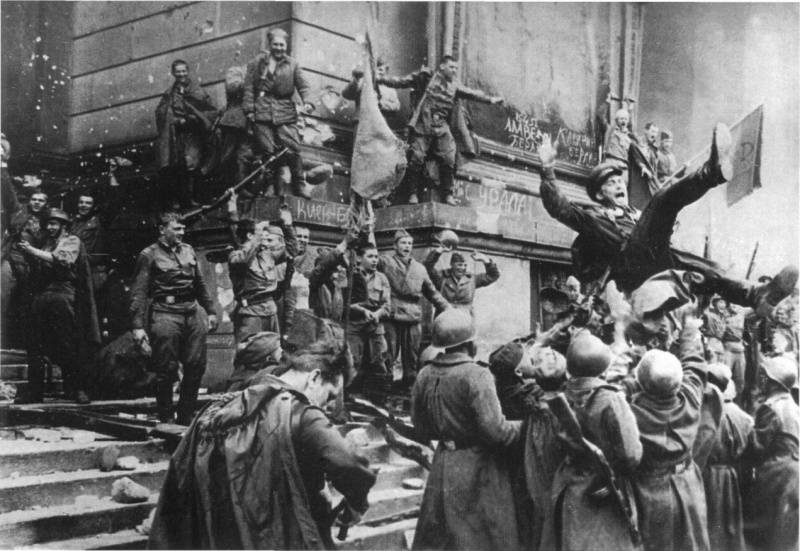
11 class student Masha Fomenko recalls: “On the eve of Victory Day, I went to my grandmother Larisa Markovna and learned from her: it turns out that my great-grandfather Mark Dmitrievich Fomenko fought in this war. A young boy, Mark, got into the village of Olshanka along with his parents, brothers and sisters. Here he met a girl, Maria, and they got married. When the MTS was created in the Olshanka farm in 1936, the great-grandfather graduated from the chauffeur courses, got a job in the “lorry”, where he worked until the very beginning of the war. Mark Dmitrievich hit the front in 1941 year (from the first days of the war).
A wife and four children remained at home, the oldest was eleven years old, and the youngest was four months old. In the city of Salsk, he underwent a short course of a young fighter and was sent along with other guys to the front, to the defense of Stalingrad. It was his duty to bring shells to the soldiers, in his possession was still the same "lorry".
One day my great-grandfather had such a case: he was driving a car with ammunition, a German plane flew at that time and began to bomb, fortunately, he managed to jump out of the car and hide nearby, the German bomb hit right in the carpentry, nothing was left of the car. After this incident, he said that "he was born in a shirt." The unit commander gave Mark Dmitrievich a new ZIS car. He continued his service in the transport of shells.
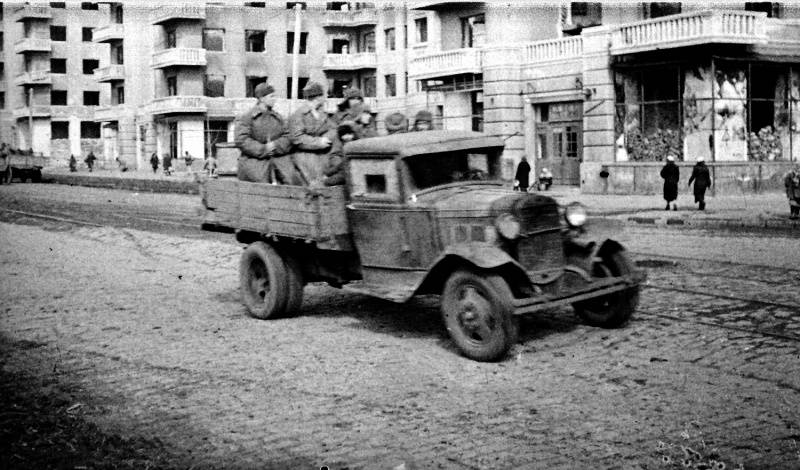
When the second year of the war was going on, the soldiers' uniforms were outnumbered, they hadn’t received a new uniform for a long time, then the unit commander summoned his great-grandfather and said: “Mark, I know that your father was a tailor. You see the guys worn out. Here's a sewing machine for you, sit down and dress the soldiers. ” He could not sew on a sewing machine, so I had to work manually. Of course, it worked for a long time, and the work was no end. Gradually, the great-grandfather mastered the sewing machine and even adapted to sew a new form: unpack the old, torn, cut out a new one and sew it. Of course, all this was done between fights.
Mark Dmitrievich participated in the battles for Bryansk, Gomel, liberated Poland. In Warsaw, our soldiers were greeted, embraced, and kissed like relatives, but there were still Poles who could have stabbed a knife in the back of our soldiers.
My great-grandfather also participated in the storming of Berlin. He brought home a photograph where he and his comrades sat on the steps of the Reichstag.
My grandmother managed to keep a photo of my great-grandfather and even restore it. Mark Dmitrievich was awarded with the following military awards: “For the liberation of Stalingrad”, “For the Battle of Moscow”, “For the liberation of Warsaw”, “For the Victory over Germany”. The commander allowed the great-grandfather to take the sewing machine home, it has survived to our time and now stands with her grandmother. And Mark Dmitrievich became a professional tailor. In the post-war period, he organized a sewing workshop in Olshanka and became the head, with three masters under his command. So until the end of his years, great-grandfather worked in this workshop. I am proud that I had such a brave great-grandfather!
Unfortunately, my grandmother does not remember the stories about the war from her father, but I wanted to know more, and then I tried to find information on the Internet. So, on request in the search engine, I learned about the feat of his great-grandfather.
In 1944, he drove horses from the open space, a wagonload of wounded people and ammunition for the squadron. For the combat ingenuity of the guard, the foreman Yakov Vlasovich Pilguev was awarded the medal “For Courage”. This, of course, is only one of his battle honors. In one of the fierce battles, my great-grandfather was seriously wounded and was taken to the hospital, and after treatment he was commissioned, and he returned home.
A few months later came the long-awaited victory. But the echoes of that terrible war were - fragments that brought unbearable pain until the end of his life. My grandmother told me that because of the injury, he could not go to meetings with fellow soldiers, so every year on May 9 her father sat in front of the TV and watched the Victory Parade with tears in his eyes. ”
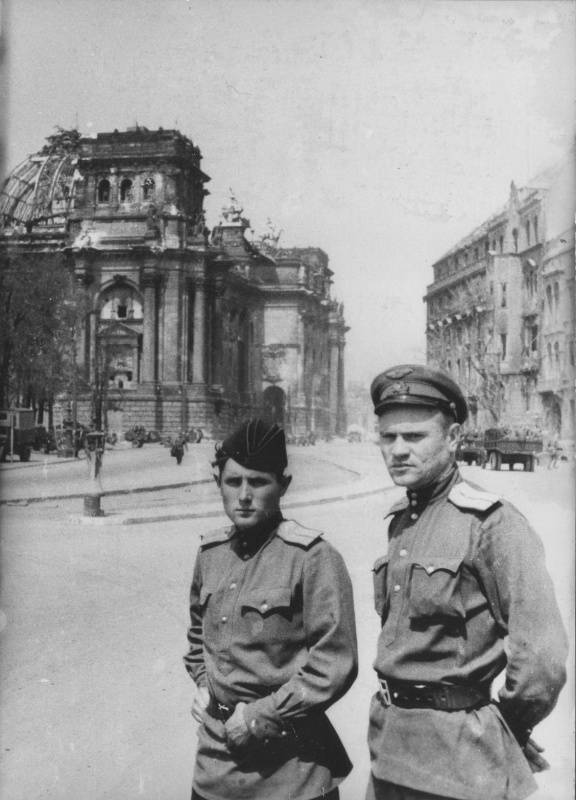
The secret of military photography
Sergey Osenchinin, a resident of the city of Volgodonsk, is fond of collecting books, and once, in 90-s, he acquired a three-volume book of Aksakov, who until recently had remained unread. And so, on the eve of the celebration of the 71 anniversary of the Great Victory, he opened this book, from which the picture turned yellow. On the back of the picture it was written in ink: "16 August 1941 year. The memory of the medical workers of the Romanovskaya stanitsa".
Smiling girlish faces, light dresses, in the fashion of that time, hairstyles, and the consciousness that a terrible cloud of cruel war hung over these people.
Frankly, the belief that someone would recognize the health workers of those years and shed light on the history of their lives was weak, because a lot of time had passed. But soon a resident of the village of Romanovskaya Nina Alekseevna Chernaya phoned. I met with Nina Alekseevna, who could not hold back her tears, confirming the uniqueness of the picture.
- I am well acquainted with this photo. In 2011, exactly the same thing passed to me, shortly before my death, Vera Afryasevna Skrytnik (nee Kostryukova), with whom we were friends. In the photo she is the twelfth on the left, in the top row. At that time, Vera Afanasyevna worked as a chief accountant at the district health department. The picture was taken on the occasion of the wires to the front of the nurse Anna Afanasyevna Zabaznova, she is the third left in the bottom row, - so began her story Nina Alekseevna.
- Vera Afanasyevna treasured this picture very much and asked to be transferred to the museum, which I did. Perhaps he is now stored somewhere in the reserve funds of the museum. The reason why V.A. Skrytnik gave the photo to me, explained simply. Then I worked in the children's library of the Romanovskaya village, was fond of history, collected materials. In total there were four such pictures. I know that another such was Taisia Topilina. She was a nurse at the maternity ward and is also in this picture, but I cannot say which one of the girls is Taisiya. Vera Afanasyevna also recalled that the farewell was hilarious, no one thought that the war would drag out and bring monstrous sacrifices.
After the story N.A. The black investigation went much easier. I met with Tatiana Sergeevna Plotnikova, the daughter of Vera Afanasyevna, and asked to share memories of her mother.
- This photo is Vera Afanasyevna 20 years old, she is 1921 year of birth. In April, the fortieth she got married, and two months later she took her husband to the front, and with her 10 her older brothers. The Cossack hive was empty, in which three remained - she, Vera's mother and her younger 10-year-old brother. His father, Afanasy Kostryukov, was serving a sentence in the Far East for the fact that his ancestor faithfully and faithfully, as befits a Cossack, served the Motherland, but with a different system. He fought along with Ataman Platov, was granted the rank of captain and manor in the Voronezh parish. But the Cossack could not live in a foreign land, he sold the estate and returned to the Don, where, with the money raised, he built houses for three sons. One of these houses, to which 123 of the year, still stands in the Romanovskaya village almost in its original form and now belongs to the Plotnikov family.
- This house is our family nest, in which more than one generation has grown. Each of us has his own memories with him, says Tatyana Plotnikova.
- Mom and grandma survived the occupation here. On the post they had a Romanian officer. Not offended, and even sometimes gave the products. But the younger mother's brother did not live to Victory. All the older brothers were killed on various fronts. She did not wait for her husband.
Married for the second time in 1950. Vera Afanasyevna died in 2012 year. One can say about her in three words - a simple, modest worker who did not like to talk about her experiences.
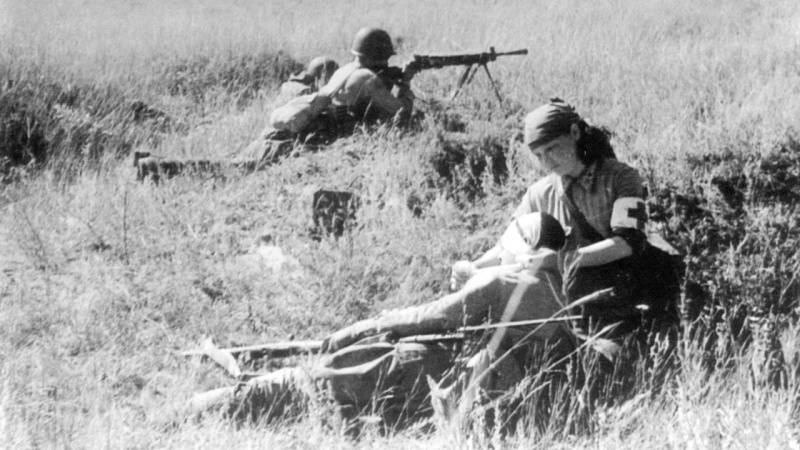
Frontovichka Zabaznova
Probably, there is no person in the Volgodonsky district of the Rostov region who would not have heard the name - Anna Afanasevna Zabaznova.
Most accurately this woman can be described by the phrase: life devoted to people.
Her grandson, Vladislav Vinnikov, says this about her grandmother:
- Unbending will-power man, a front-line soldier, not afraid of any difficulties. Relatives rarely saw her sleeping. Until late at night she resolved organizational issues, especially if it concerned the well-being of his countrymen. Anna Afanasyevna loved to repeat: "The main thing is people." In the morning she rose before everyone else. We had the impression that she did not go to bed at all.
Anna Afanasyevna’s credo “the main thing is people” happened in her deep youth, so she graduated from the first-aid and obstetric school in Rostov-on-Don in order to help her be born into a new life. She worked for only two years and in August 1941 went to the front. This moment captured the image found.
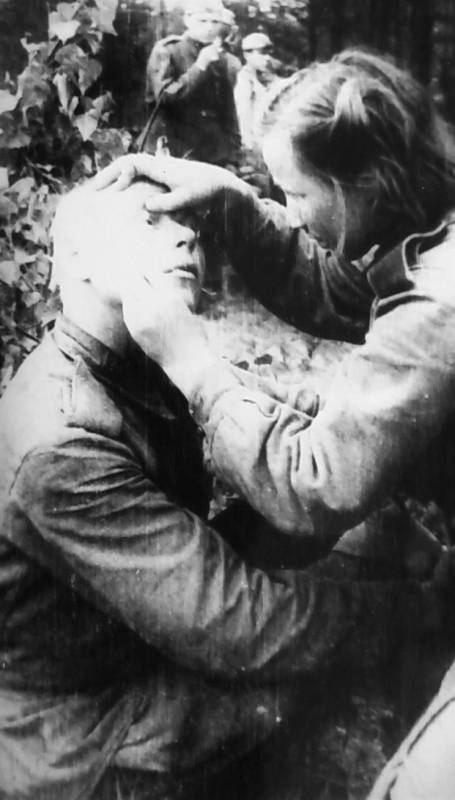
In the course of investigative journalism, we found out that at the beginning of the war she worked as a senior nurse in the Novocherkassk evacuation hospital, and since April 1943, Anna Afanasyevna was a medical orderliest of the 4 machine-gun squadron of the cavalry guard corps. Saninstruktor cavalry corps! Now it is difficult to imagine. Always in the saddle, always on the front. It is blood, the daily pain of loss and the lives of soldiers saved. And every minute the willingness to part with his own life. There are few episodes that detail Anna Afanasyevna’s front-line everyday life, but one that breathes with such strength of mind that her heart stops is remembered in her family.
The front line passed from hand to hand. Saninstruktor Zabaznova pulled out the wounded, shed tears over the dead, of whom there were many, there was no time and energy. At some point, the Nazis went on the offensive. Anna was cut off from her, she had to hide among the dead. The noise of the onslaught of the enemies inexorably approached, she pulled out a pistol and put the barrel in her mouth. Being discovered by enemies means captivity! And the girl, in order not to fall into the hands of the enemy, decided to shoot herself. And everyone who knew Anna Afanasyevna at least a little bit is sure that she would do it. Then there was an explosion, and the girl lost consciousness. God did not turn away from the Cossack - this piece of land again recaptured our troops.
Anna Zabaznova ended the war as a paramedic of a surgical platoon of the 13 th medical unit of the 9 th Guards Cossack Division in Prague. Demobilized in September 1945. The chest was decorated with two orders of the Red Star and 5 medals, including "For Courage" and "Martial Merit".
In peacetime, she began to work as a senior nurse, but battle wounds and contusion were felt. Work had to leave for some time. The desire to be useful to people won ills, and Anna Afanasyevna returned to duty. Was the chairman of the village council, a deputy of the Rostov Council of People's Deputies. Her favorite child was the veterans' choir, which she organized, putting her soul into it. Now the choir bears her name, has the title of national. Anna Afanasyevna has always been concerned with everything: is there a water supply system, a garden, asphalt roads in the village? And this is not on duty, but at the call of the heart.
Information